JARS v58n4 - Yunnan, A Botanical 'House'?
Yunnan, A Botanical 'House'?
Dr. Henri Galibert
Saint Geniez d'Olt
France
If the Himalaya is said to be the "roof of the world," Yunnan can be called the "attic of the world" because of its great richness.
Why can we speak of an attic? East of the Himalayan range, Yunnan, China, is composed of high mountains more than 3,500 meters (11,483 ft.) high (5,740 meters for the Meili Shu Shan), deeply cut by three parallel rivers facing north-south: Salween, Mékong and Blue River (Nu, Lang-kang, Yantseu Kiang). Throughout millennia, this remarkable geographic situation has allowed incessant exchanges and phenomena of botanical adaptation between the northern cold zones (Tibetan plateau) and the tropical zone of southern China. Yunnan was spared by glaciations and is subject to the monsoons regime, which allowed the area to keep a very rich flora: 16,000 species compared to 4,000 in France.
This geoclimatic unity gives the Yunnan area a mild climate (few frosts) with a dry season from October to April and a humid one from May to September in rather high altitudes, so that you can find Mediterranean plants in Kunming, the provincial capital which is located at an altitude of 1,850 meters (6,070 ft.). These plants are settled in the open ground, such as amaryllis, bougainvillea, grevillea, palm trees or cactus; besides, the translation of the name "Kunming" is unequivocal: "The City of Eternal Spring." That'll take some doing!
This climate combined with high mountain ranges with very steep slopes permits us to draw very clear levels of vegetation. The different "floors" of vegetation are:
• A tropical level for the lowest altitudes
• A subtropical one up to 2,000 meters (6,562 ft.) with cacti, bougainvilleas, tree ferns, fir trees, epiphytes
• A mixed forest of conifers and bamboos up to 3,500 meters (11,483 ft,): eucalyptus, pine trees, bamboos, hemlock, rhododendrons
• An alpine level above 3,500 meters (11,483 ft.)
Moreover, the important role of the mountainous sides that position where the rainfall, the sunshine and the ultraviolet rays (we are 2,000 meters high on average) play a major part on the flora is underlined. So, going from one side to another leads a notable change in the plants which are found.
Yunnan Through Our Trips
These climatic and geographical facts, combined with the botanical richness found in this area, justify the curiosity that Yunnan arouses in the view of amateurs and professionals of botany, in particular for the rhododendrons in this province, which comprise a good third of the species known.
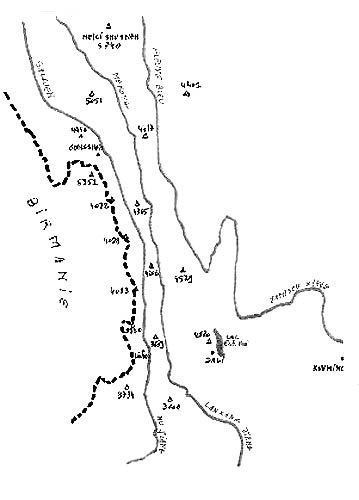
|
|
The area of Yunnan trekked by the author's party.
Mountain elevations are in meters |
A first trip was organized in 1999 by Mr. Raymond Grall and a second one in 2002 by Mr. Patrick Bellec. So, amateurs, collectors and professionals gathered, with the technical advice of Mr. Jean Merret (Huelgoat Arboretum), to compare their rather artificial horticultural knowledge with the discovery in the real world, on the open country. Moreover, the imposing landscapes of these deep valleys, of these villages still typical of ancient fortified towns such as Dali, of populations (the "minorities") expressing their difference through their varied - even shimmering - dress add an undeniable tourist appeal. However, the important rainfalls lead to many landslides which often cut off roads or tracks, the only means of access to the beauty spots. Annoyances and changes of plan are frequent, and walks are longer than expected.
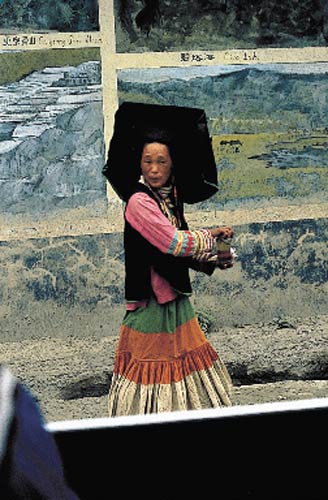
|
|
Woman of the Salween valley.
Photo by Henri Galibert |
Instead of an individualization of both trips, we are going to describe two special cases: Cangshan mountains and the Salween valley.
Cangshan Mountains
Cangshan mountain, which is 4,120 meters (13,518 ft.), is the highest peak in a small steep range with marvelous surroundings: down the mountain, in the east, a long rice field plain with a big lake and Dali, encircled with ramparts. Leaving from Dali (1,900 meters, 6,234 ft.), we can find a first level of vegetation, 2,000-2,500 meters (6,562-8,203 ft.) high. This level is rather dry with pine trees ( Pinus yunnanensis and P. armandii ), Rhododendron virgatum ssp. oleifolium and R. pachypodum .
A bit higher, a more temperate level acquires an identity of its own with Rhododendron neriiflorum , R. irroratum , R. maddenii ssp. crassum , R. maddenii , camellias, pieris, enkianthus and above all bamboos, which gives the name of bamboo forest. The few trees are fir ( Abies ).
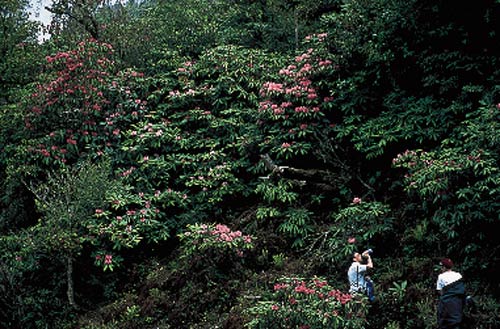
|
|
Forest of rhododendrons.
Photo by Patrick Bellec |
Then comes what is called the rhododendron forest, with small shrubs several meters high, under which the vegetation is poor and where you can only see the rhododendrons' twisting trunks, which are sometimes colored red-purple ( R. cyanocarpum ). The leaves and the flowers are set high up above our heads and almost invisible against the sunlight ( R. lacteum ), which is frustrating.

|
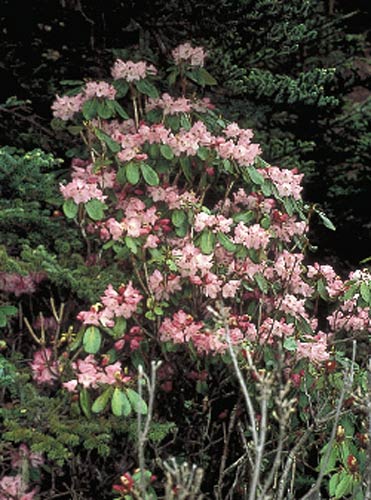
|
|
|
Cangshan forest with
R. lacteum
Photo by Jean François Petton |
R. cyanocarpum
, Cangshan.
Photo by Jean François Petton |
Higher, you can find the last level composed of smaller and smaller rhododendrons: 1.5 meters (5 ft.) high for the R. haematodes , R. aganniphum , R. flavorufum and some R. lacteum , which becomes almost creeping as you gain in altitude because of the winter snow weight. The R. impeditum and R. fastigiatum , dwarf rhododendrons, end this alpine level.
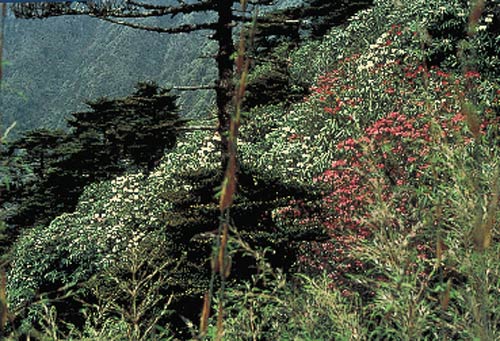
|
|
Cangshan.
R. rex
ssp.
fictolacteum
.
Photo by Jean François Petton |
We have to note that some rhododendrons are on several levels ( R. neriiflorum , R. lacteum , R. cyanocarpum ). So, their flowering is spread out for the observer who goes up in altitude.

|
|
R. roseatum
Photo by Henri Galibert |
Salween Valley
The Salween valley is another example of this level of vegetation. It spreads from Liuku to Gongshan where the road stops; it's a track 250 km (155 miles) long with an altitude from 900 meters (2,953 ft.) (Liuku) to 1,500 meters (4,922 ft.) high (Gongshan). The fluvial erosion v-shaped valley is deep and lined with peaks which are more than 3,500 meters (11,483 ft.) high.
The bottom of the valley recalls the subtropical climate with tree ferns, euphorbias, fokinias, mangletias and magnolias. Unfortunately, man's imprint is quite evident with an important deforestation intended to create rice fields and food crops on the steepest slopes of the mountains. The king tree (cultivated) is the walnut tree.
To find again the former vegetation of these slopes, you have to go to Pianma reserve which is an adjacent valley where you can see big Abies delavayi , Rhododendron protistum var. giganteum , which can be 15 meters (49 ft.) high, also big specimens of R. sidereum with light yellow flowers, light pink R. rubiginosum and R. arizelum which are more rare. In this very humid big forest, many epiphytes R. ciliipes (Davidian), R. maddenii , R. edgeworthii and scurrula can be found.
Above this level, Rhododendron rubiginosum , R. uvarifolium (big ones) and then (in Gongshan area) R. sanguineum , R. dichroanthum , R. crinigerum , R. glischrum and R. praestans appear up to the first snow limit.
It's obvious that man's imprint alters landscapes, wildlife and flora, and that it's not easy for us to find wild enough settings, even in these very remote regions, to observe a spontaneous flora. But the whole attraction of such a trip lies in its difficulty, doesn't it?
That is Yunnan, under the roof of the world (Tibet), whose door key is an above-average amount of courage to climb all those subtle "floors," to travel up and down this attic full of so many botanical treasures and to watch the minorities live in their house.
Reference
Pf Guan Kaiyun, conference, Kunming Botanic Institute (8/5/2002).
Dr. Galibert is a species collector in south-central France. He collaborated with Grall, Lennon and Claustre's for the book Les Rhododendrons and has written articles for French and ARS publications. His article "Rhododendron Cutting- Grafting" was published in the Fall 1997 Journal.
